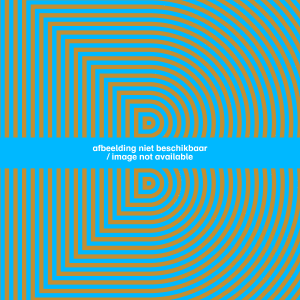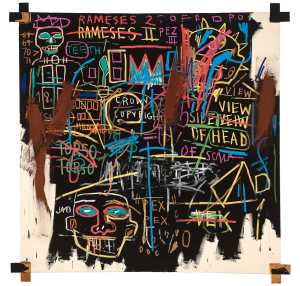The portraits of this couple, Dalí and his wife Gala, are formed by the contours of the frames. The composition of this work - the position of the heads - is borrowed from a famous painting by one of Dalí's favourite artists, the French painter Jean François Millet. 'The Angelus' shows a farmer and his wife saying evening prayers in their field. Dalí and Gala have assumed the same postures.

Specifications
| Title | Couple aux têtes pleines de nuages |
|---|---|
| Material and technique | Oil on panel |
| Object type |
Painting
> Painting
> Two-dimensional object
> Art object
|
| Location | This object is in storage |
| Dimensions |
Height 98,5 cm Width 156,4 cm Depth 4,5 cm |
|---|---|
| Artists |
Artist:
Salvador Dalí
|
| Accession number | 2988 a-b (MK) |
| Credits | Purchased with the support of Stichting Museum Boijmans Van Beuningen, Rembrandt Association, Cultuurfonds, Erasmus Foundation, and Stichting Bevordering van Volkskracht, 1979 |
| Department | Modern Art |
| Acquisition date | 1979 |
| Creation date | in 1936 |
| Collector | Collector / Edward James |
| Entitled parties | © Salvador Dalí, Fundación Gala-Salvador Dalí, c/o Pictoright Amsterdam 2022 |
| Provenance | Alex Reid and Lefevre Gallery, London 1936; Edward James, Chichester 1936-64; Edward James Foundation, Chichester 1964-79; on loan to Brighton Museum and Art Gallery c. 1966-79 |
| Exhibitions | London 1936b; New York 1936; New York 1965; Rotterdam 1970-71; Paris 1979; Charleroi 1985; Brighton 1998; Liverpool/St Petersburg 1998-99; London/New York 2001-02; Barcelona/Madrid/St Petersburg 2004-05; Cologne 2006; Paris/Madrid 2012-13; Edinburgh/Hamburg/Rotterdam 2016-17 |
| Internal exhibitions |
The Collection Enriched (2011) Gek van surrealisme (2017) De collectie als tijdmachine (2017) |
| External exhibitions |
Dalí ontmoet Vermeer (2011) Dalí (2012) Dalí, Ernst, Miró, Magritte... (2016) Surreal Encounters - Collecting the Marvellous (2016) Dal nulla al sogno (2018) Dalì & Magritte (2019) Surrealist Art - Masterpieces from Museum Boijmans Van Beuningen (2021) Only the Marvelous is Beautiful (2022) Dalí, Magritte, Man Ray and Surrealism. Highlights from Museum Boijmans Van Beuningen (2023) A Surreal Shock – Masterpieces from Museum Boijmans Van Beuningen (2021) A Surreal Shock. Masterpieces from Museum Boijmans Van Beuningen (2023) |
| Research |
Show research A dream collection - Surrealism in Museum Boijmans Van Beuningen |
| Literature | Rotterdam 1970, cat. no. 43; Dalí/Pauvert 1978, p. 83; Paris 1979, pp. 290-91, 276-77, fig. 222; Descharnes/Néret 1994, pp. 272-73; Finkelstein 1996, pp. 195-97; Descharnes 1997, p. 200; Brighton 1998, p. 60; Ades/Bradley 1998, p. 27, fig. 31; Venice/Philadelphia 2004-05, p. 256, fig. 3; Barcelona/Madrid/St Petersburg 2004-05, p. 81, fig. 74; Figueres 2004-present, no. 443; London/Rotterdam/Bilbao 2007-08, pp. 280-81, cat. no. 14; Rotterdam 2007, pp. 107-09; Paris/Madrid 2012-13, pp. 179, 172; Edinburgh 2016, pp. 22, 36, 205, 215, 246, cat. no. 34 |
| Material | |
| Object | |
| Geographical origin | Spain > Southern Europe > Europe |
Entry catalogue A dream collection - Surrealism in Museum Boijmans Van Beuningen
Author: Marijke Peyser

Although the title of Salvador Dalí’s diptych, Couple aux têtes pleines de nuages, does not explicitly refer to the artist and his muse Gala, the portraits do indeed feature the painter and his mistress. This is confirmed by the photographs that Cecil Beaton took of the works of art in the year Dalí and Gala posed behind the figures.[1]
The unusual shape Dalí gave each portrait corresponds to the upper parts of the bodies of the man and the woman in Jean-François Millet’s L’Angélus (1857-59). In the early 1930s Dalí made a number of works that literally cite L’Angélus or refer to it.[2] The artist believed that this work by Millet was ‘the most disturbing, the most enigmatic, the most layered, the richest work in terms of unconscious thoughts that was ever made’.[3] With due regard for his ‘paranoiac-critical method’ Dalí was inspired by this nineteenth-century painting. In the essays ‘L’âne pourri’ (1930) and ‘Interprétation paranoïaque-critique de l’image obsédante de L’Angélus de Millet’ (1933) Dalí explained that his method allowed him to analyse his own paranoid thoughts, to keep the obsessions and hallucinations that were caused by this illness under control and to use them in his creative work.[4] Instead of a simple farmer and his wife who cease their work in the twilight and recite the Ave Maria, Dalí saw the woman as a praying mantis getting ready to devour the man. Dalí saw the man, who according to him was trying to hide his erection with his hat, as her victim who was going to die.
Couple aux têtes pleines de nuages is also the title of another diptych that Dalí likewise painted in 1936.[5] These are probably two men and the work refers to the friendship between the poet Federico García Lorca and Dalí.[6] On 19 August 1936 Lorca was killed by the Fascists during the Spanish Civil War (July 1936 – April 1939). The loss of his childhood friend reminded Dalí of Lorca’s oft-expressed fear of death that led him to repeatedly act out informally, in Dalí’s presence, his death, burial and decomposition.[7] In the ‘Lorca period’, from 1925 to 1927, Dalí depicted Lorca’s head accompanied by, or linked to the shadow of the painter’s head.[8] In the diptych death has separated them. The depiction of the poet and the painter is similar to the description that Ian Gibson, an expert on the life and work of the two Spaniards, gave of the work: ‘Dali’s oval face and characteristic little stick-out ears, juxtaposed with Lorca’s broad head, the ears of which, also prominent, contrast, in their chunkiness, with the painter’s’.[9]
Footnotes
[1] Descharnes/Néret 2005, p. 272, no. 610.
[2] See for example L’Angélus (c. 1932), Le spectre de l’Angélus (c. 1934), L’Angélus architectonique de Millet (1933), Atavisme du crépuscule (1933/34), Les chants de Maldoror (1934), L’Angélus de Gala (1935), La Gare de Perpignan (1965), Aurore, midi, couchant et crépuscule (1979).
[3] Paris/Madrid 2012-13, p. 172.
[4] Paris 1979, vol. I, for ‘L’âne pourri’, see pp. 276-77; for ‘Interprétation paranoïaque-critique de l’image obsédante de L’Angélus de Millet’, see Minotaure, Revue artistique et littéraire, 1 (1933).
[5] See Descharnes/Néret 2005, p. 272, no. 612.
[6] See Venice/Philadelphia 2004-05, p. 256.
[7] Gibson 1997b, pp. 185-86.
[8] Gibson 1997a, p. 168; see for example Natura morta (Invitació a la son) (1926) and Nature morte au clair de lune (1926).
[9] Ibid., p. 172.
All about the artist
Salvador Dalí
Figueras 1904 - Figueras 1989
Salvador Dali got to know the author André Breton - the founder of the surrealist movement - while he was studying in Madrid. In 1924, Breton wrote the first...
Bekijk het volledige profiel























